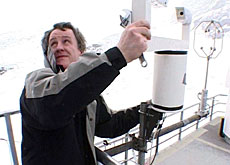Particles cloud researchers’ judgement

Ernest Weingartner is a man with his head in the clouds.
As an expert in atmospheric chemistry at the Paul Scherrer Institute in northern Switzerland, he spends a lot of time measuring them.
His particular interest is the particles in the air, known as aerosols, which influence cloud formation and affect both our climate and health.
Along with an international group of collaborators working at Switzerland’s Jungfraujoch research station – 3,500 metres above sea level in the Bernese Alps – he’s starting to unravel the mystery of how aerosols and clouds interact.
“We still need a lot more knowledge about aerosols,” says Weingartner. “There’s still a great deal of uncertainty about how they act.”
The study of aerosols is important for a number of reasons.
Many of the particles reflect solar radiation back into space and may offset the effects of global warming.
In addition, there are growing concerns about their effect on human health. Owing to their small size, they can penetrate very deeply into the lungs.
Light work
Tiny organic aerosol particles result from the burning of fossil fuels, as well as from natural sources like vegetation.
Others are formed by secondary processes in the atmosphere under the influence of solar radiation and are known as secondary organic aerosols (SOA).
The scientists are measuring properties such as size, size distribution, the way in which these particles take up water, as well as their chemical composition.
The implications of their work are considerable. Some aerosol particles have the ability to offset the effects of global warming – the heat-trapping build-up of carbon dioxide emissions in the atmosphere.
These particles, which can scatter light back to space, lead to a local cooling of the atmosphere.
“It is very important to understand how they act and how they absorb light,” said Weingartner.
Global warming
To complicate the picture, while some aerosol particles reflect light, others absorb it and can lead to local warming.
“The problem at the moment is we don’t know enough about these aerosols to be able to put a specific figure on how they affect the climate,” said Keith Bower, senior research fellow at the physics department of Manchester University.
“What is required is more investigation so that we can reduce the uncertainty.”
In a recent experiment at the Paul Scherrer Institute in Villigen, researchers built a smog chamber and pumped a mixture of gases into it, corresponding to the composition of the air on a summer’s day.
They then simulated atmospheric ageing with sunlight and saw that secondary aerosol particles were formed.
Ice crystals
Researchers are also interested in how these particles affect cloud formation.
When water droplets join with some of these microscopic particles in the atmosphere, clouds form.
Cold and warm clouds differ in their properties. In summer, clouds consist mainly of liquid droplets, with particles such as soot incorporated in them.
The cold winter clouds consist of droplets and ice crystals.
As the ice crystals grow – by a process which is only partially understood – they fall out of the cloud and melt on the way down returning to Earth as precipitation in the form of rain, snow, sleet and hail.
“We don’t know much about it,” admits Stefan Mertes from the Institute for Tropospheric research in Leipzig, Germany.
“We expect that there is a certain kind of aerosol particle which initiates the ice nucleation in these clouds but we don’t know the physical or chemical state of those particles, and we don’t know if they are natural or man-made.”
swissinfo, Vincent Landon
Observation of cloud and aerosol particles has been conducted at the Jungfraujoch since 1988.
The first CLACE campaign – Cloud and Aerosol Characterization Experiment – took place in February / March 2000.
The main goals of CLACE are to examine cloud formation processes under different conditions and to characterise organic aerosol compounds.
Clouds have an effect on the earth’s energy budget by reflecting the solar radiation back to space.
The CLACE-3 campaign is currently in progress, with CLACE-4 planned for next year.

In compliance with the JTI standards
More: SWI swissinfo.ch certified by the Journalism Trust Initiative











You can find an overview of ongoing debates with our journalists here . Please join us!
If you want to start a conversation about a topic raised in this article or want to report factual errors, email us at english@swissinfo.ch.